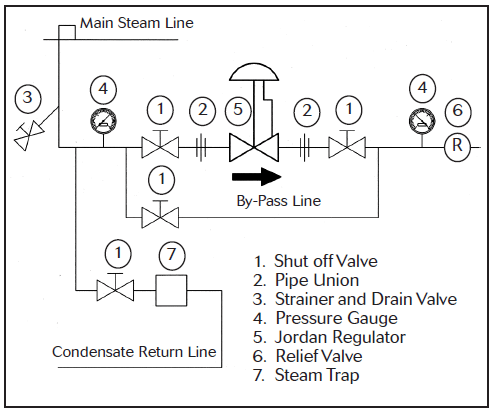Supplier Resource

Ideal Installation of a PRV in a Steam System
The following technical guide from Jordan valve show the ideal installation of a pressure relief valve in a steam system.
- To protect the valve from grit, scale, thread chips and other foreign matter, ALL pipelines and piping components should be blown out and thoroughly cleaned before the installation process begins.
- Shutoff valves, pressure gauges and by-pass piping should be installed as indicated in the Ideal Installation Schematic to provide easier adjustment, operation, and testing.
- A line strainer should be installed on the inlet side of the valve to protect it from grit, scale and other foreign matter. A 0.033 perforated screen is usually suitable for this purpose. Line strainers are available from Jordan Valve.
- For best control, 3’ 0” straight sections of pipe should be installed on either side of the valve.
- In preparing threaded pipe connections, care should be exercised to prevent pipe-sealing compound from getting into the pipelines. Pipe-sealing compound should be used sparingly, leaving the two end threads clean. Jordan uses, and recommends, thread sealer Teflon ribbon.

- The flow arrow on the valve body must be pointed in the direction of flow. Ideally, the valve should be installed in the highest horizontal line of piping to provide drainage for inlet and outlet piping, to prevent water hammer, and to obtain faster response.
- If possible, install a relief valve downstream from the valve. Set at 15 psi above the control point of the valve.
- In hot vapor lines, upstream and downstream piping near the valve should be insulated to minimize condensation.
In gas service, if the control pressure (downstream)is 25% of the inlet pressure or less, expand the outlet piping at least one pipe size. A standard tapered expander connected to the outlet of the valve is recommended. - Where surges are severe, a piping accumulator is recommended.
On steam control applications, install a steam trap with sufficient capacity to drain the coil or condenser. Be sure to have a good fall to the trap, and no back pressure. Best control is maintained if the coil or condenser is kept dry.
For more information, or see ideal installation steps for the Control Line, (required in externally-sensed pressure regulating valves) contact a process solutions expert from Cross Company.
As a distributor for Jordan Valve throughout our territories in the U.S. Mid-Atlantic region, Cross company offers a range of products along with expertise to ensure your operating is running efficiently. Contact us today for a quote or to learn more about our full offering from Jordan Valve.



